Thanks to the COVID-19 pandemic, public transit in the Twin Cities has changed dramatically. When the bottom dropped out of ridership, Metro Transit suspended 63 routes and reduced service on many more. All over the metro, as part of the short-term triage, bus stop signs received stickers saying there was no longer any service. Now things have more or less stabilized and it’s time to ditch the temporary fixes and adapt to the new normal. The agency has rolled out a sweeping draft plan dubbed Network Now for public comment. Assuming most of it is adopted, it will be the biggest one-time transit makeover in history.
The plan is influenced by three main factors:
- The downtown office commuter market is dramatically smaller due to at-home work
- The system is being reshaped and expanded with new BRT lines and the Green Line Extension
- The legislature approved a sales tax that will finally provide an adequate and stable
funding source
To a large extent, the new plan reinvests money formerly spent on downtown office commuters via suburban express service. In the process, this change has created operating efficiencies. In the past, hundreds of buses made only one or two trips each rush hour, spending the other 20 hours sitting in garages. Only half the buses were in service all day. Trying to shoehorn an 8-hour work day into those two short rush hours triggered more overtime pay and various time-and-a-half penalty pays. It required bus drivers to work a large number of split shifts that might start at 6 a.m. and not end until 6 p.m. Such shifts were unpopular with drivers and suppressed hiring. On the capital side, extreme rush hour peaking required more bus garages and more buses, and that in turn drove up maintenance and storage costs.
As the graph below shows, the a.m. peak is gone and the p.m. peak is much reduced. The result is more efficient scheduling of buses and drivers, and the same amount of service can be provided with fewer buses and less cost.
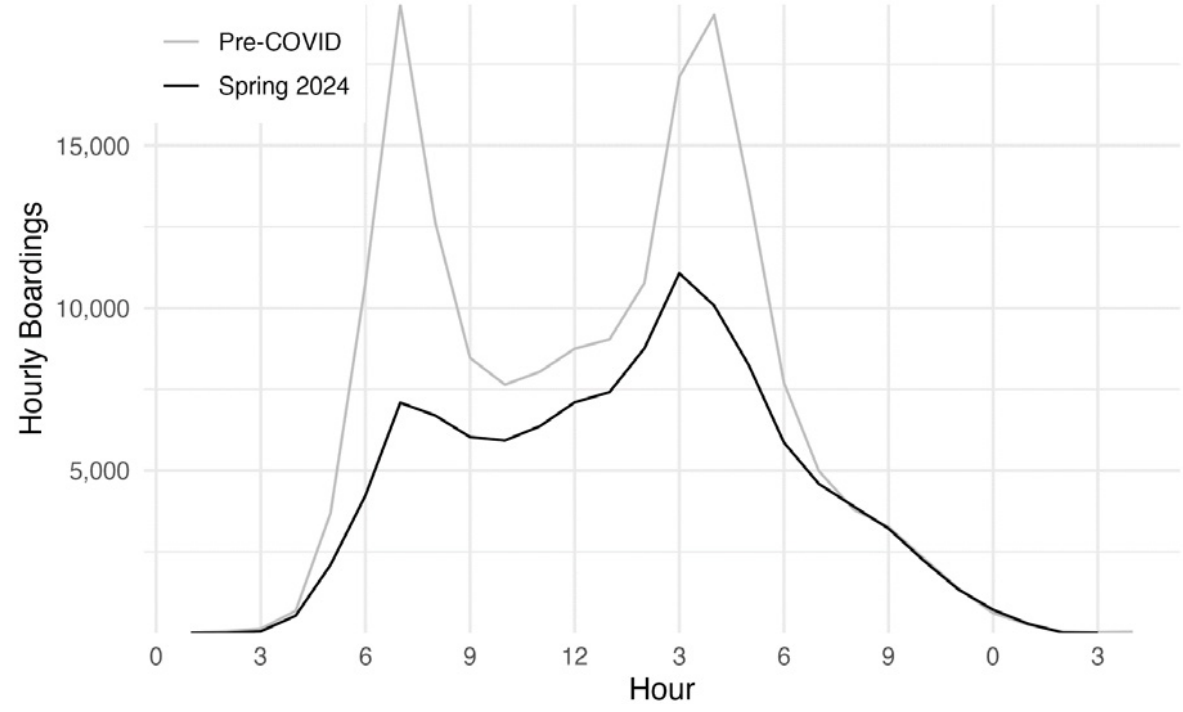
What remains of the much-reduced downtown commuter market is still worth serving, but the extensive network of express bus routes will be drastically consolidated to serve only the largest suburban park-ride lots. 47 commuter routes that had been suspended will be permanently eliminated, along with many of the smaller park-ride lots. The remaining expresses will add midday service, recognizing the reality of people working partial days in the office. By providing all-day service, the express routes should attract some miscellaneous non-commuting trips.
The bulk of the reinvestment will be targeted at people who don’t have cars or want a more car-free life. Although their most common use of transit will still be the work commute, all other kinds of trips will become more convenient.
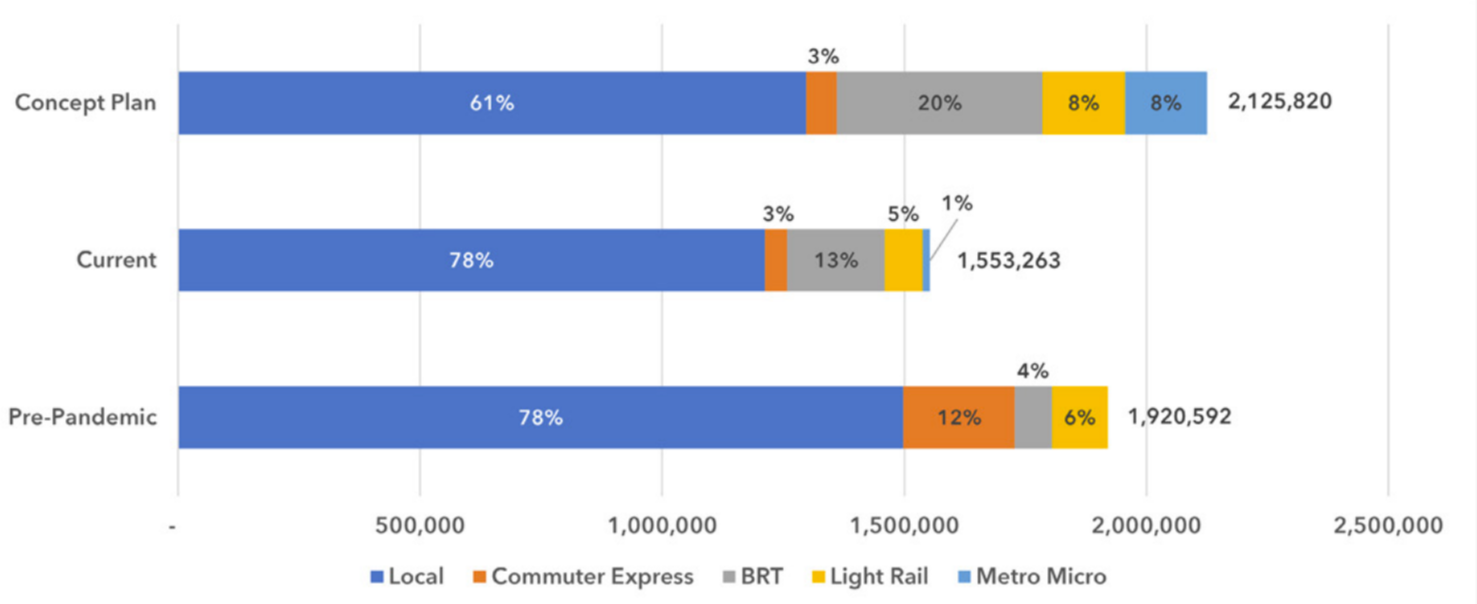
Shifts in Coverage
If there’s no transit where you want to go, you can’t use it. The current system adds some new routes to fill coverage gaps, but it’s not a major part of the plan as the route network is already pretty comprehensive. A notable improvement will be feeders to the new Gold Line BRT that will run from downtown St. Paul to Woodbury. They’ll connect it to previously unserved neighborhoods in Maplewood, Oakdale and Cottage Grove. The new Route 354 will connect Woodbury, Newport, South St. Paul and West St. Paul with the airport. Suspended Route 223 is being reinstated to connect Rosedale and Maplewood Mall via Roseville, Little Canada and Maplewood. New Route 725 will connect the Northtown Transit Center in Blaine with Brooklyn Park and Osseo. Service will be extended from Rosedale Transit Center to the redeveloped arsenal site in Arden Hills. The Green Line extension will increase route coverage in Hopkins, Minnetonka and Eden Prairie and its bus feeders will make new trips possible for the first time. New Route 757 will run the length of Hwy. 55 from Minneapolis to Plymouth.
In the suburbs, transit has always had a “first mile, last mile” problem. It’s economically impossible to achieve the urban model of half-mile route spacing to get passengers within a reasonable walk of their origin or destination. The curving streets and lack of sidewalks only make the problem worse. Network Now proposes to solve the problem with Metro micro.
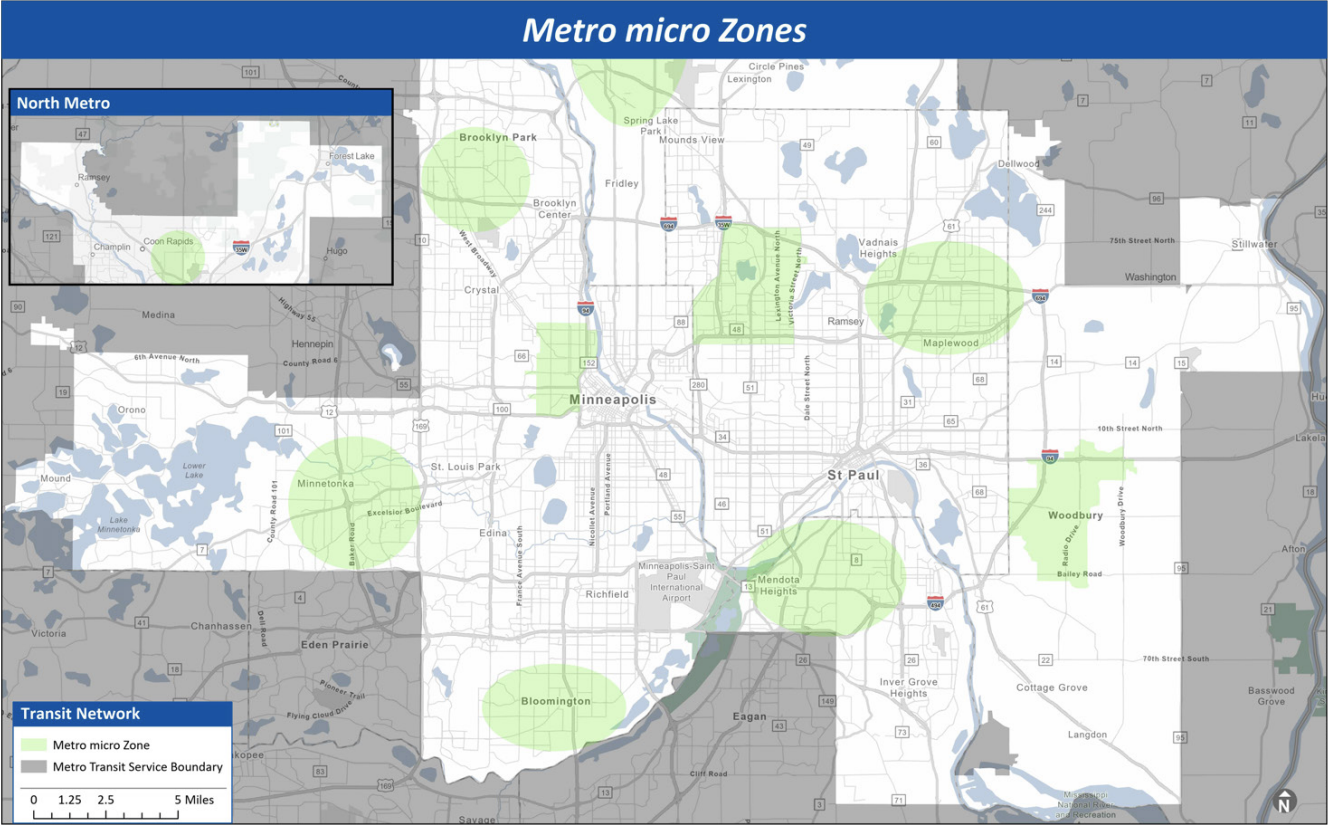
Metro micro is the brand name for a dial-a-ride service within a 2-square mile roaming area based at a major transit station or center. Its job is to meet the fixed route service at the station and fill the “first mile, last mile” gap. It works because the roaming area is so small, allowing the micro vehicle to make a timely return to the station or transit center for connections. Network Now proposes eight new Metro micro areas, in addition to the pilot currently operating in North Minneapolis. The first two will feed the Rosedale Transit Center and the Woodbury end of the Gold Line. Others will be added every year, based at Bloomington’s 98th Street Station, West St. Paul’s Dakota County Service Center, Maplewood Mall Transit Center, Blaine’s Northtown Transit Center, Brooklyn Park’s Starlite Transit Center and the Minnetonka’s Opus Green Line Station. I have high hopes for this experiment.
Better Frequency
The lion’s share of the reinvestment is being put into more frequent service. The old axiom in transit planning is that time spent waiting is perceived as twice as long as time spent on the bus. Make the bus more frequent and you make it more user friendly. Get the frequency to every 15 minutes or better and it’s no longer necessary to consult a schedule. Just walk to the stop and wait for the bus.
Proposed weekday frequency improvements:
- 18 routes go from every 12 or 15 minutes to every 10 minutes
- Three routes go from every 20 or 30 minutes to every 15 minutes
- One route goes from every 60 minutes to every 20-30 minutes
Saturday frequency improvements:
- Seven routes go from every 12 or 15 minutes to every 10 minutes
- Five routes go from every 20 or 30 minutes to every 15 minutes
- Four routes go from every 60 minutes to every 30 minutes
- Four routes go from no service to every 60 minutes
Sunday frequency improvements:
- SIx routes go from every 12 or 15 minutes to every 10 minutes
- Five routes go from every 20 or 30 minutes to every 15 minutes
- Five routes go from every 60 minutes to every 30 minutes
- One route goes from no service to every 20 minutes
- Eight routes go from no service to every 60 minutes
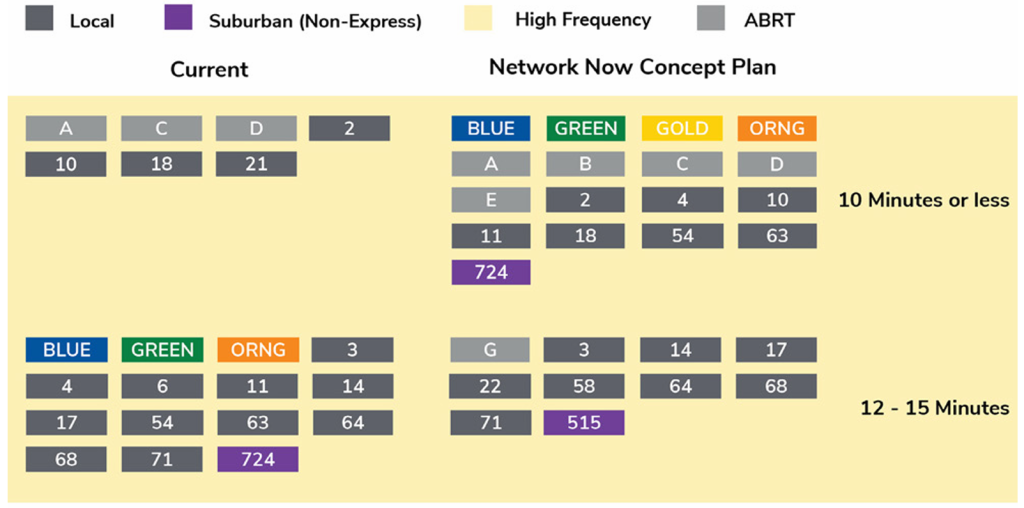
When discussing frequency, it’s important to consider transfers. No one likes having to transfer, but about a third of riders have to do it to complete their trips. Within Minneapolis and St. Paul, almost all transfers are randomly timed where the routes happen to cross each other. It’s mathematically impossible to time them except in a few cases. Therefore, frequent service is the only way to reduce transfer waits, and this plan does that.
It’s a different situation in the suburbs. There’s never going to be enough money or ridership potential to justify 15-minute frequencies, but 30 minutes is a reasonable goal. Instead of random transfers where the routes happen to cross, most suburban routes end at transit centers, and the transfers are timed to occur while the buses layover before making their return trips. The transit centers are already in place, and timed transfers are already happening there. For example, Mall of America transit station sees timed transfers twice an hour. At Brooklyn Center Transit Center, nine buses come together twice each hour. A 30-minute or even 60-minute frequency does not prevent a convenient transfer.
Improving Speed
Transit is perceived as slower than driving, although that’s not always the case. Commuter express buses frequently beat auto time thanks to MnPass lanes and bus-only shoulders. Light rail beats auto time from the airport to downtown Minneapolis and will do the same from the southwest suburbs when the Green Line Extension opens. With fewer stops, off-board fare collection and traffic signal priority, BRT has achieved moderately higher speeds where it has been implemented.
However, there’s no getting around the reality that local bus service is slow compared to the automobile. Metro Transit is increasing bus stop spacing on selected routes, and I expect traffic signal priority to be extended to local buses. The City of Minneapolis is creating bus lanes on Hennepin Avenue and Lake Street and that will help both speed and on-time performance. Those steps, combined with greater frequency, can at least max out the potential of local buses.
Extending Transit’s Reach
Major goals of Network Now are to bring frequent service to more people, and to improve transit access to jobs at all times of the day and week. On the job access graph (Figure 38), note the weekday midday, Saturday and Sunday improvements.
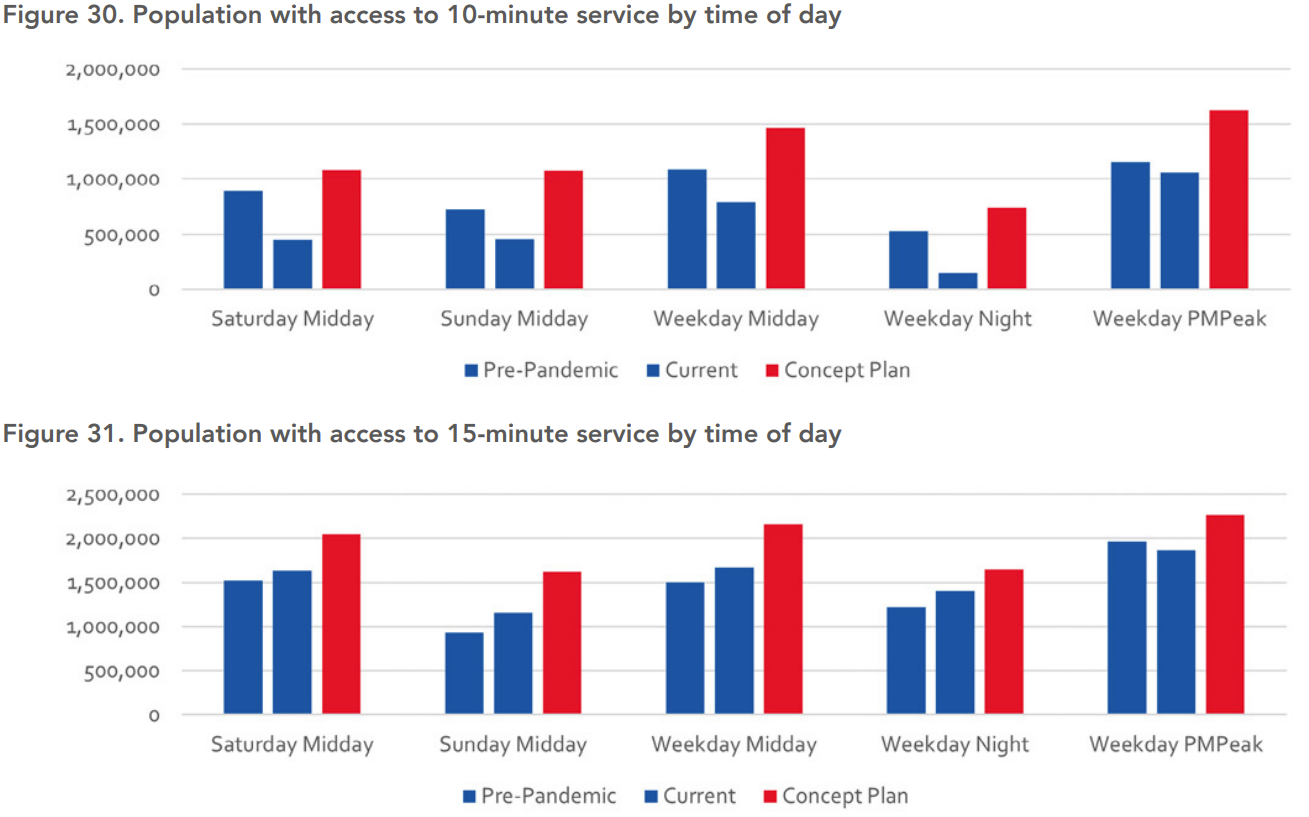
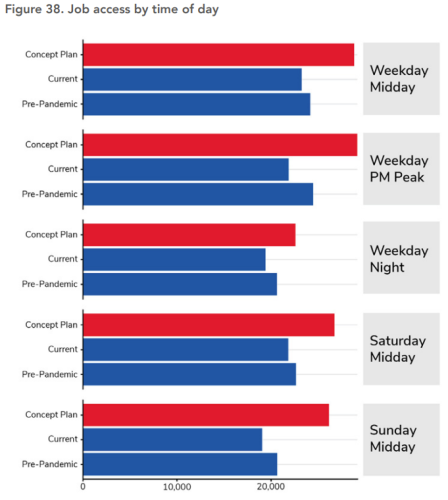
Time for Your Input
The current Network Now plan is just a draft, so Metro Transit is looking for public input. From October 1 to November 7 Metro Transit will host a series of in-person and virtual community meetings; you can find dates and locations here. Note that there is also an online form which you can use to submit comments, available here until November 15. Metro Transit will continue to revise the plan based on public comment before submitting it to the Metropolitan Council early next year.
For more context and information about Network Now, check out H. Jiahong Pan’s piece on the subject on Minnpost, and view a PDF of the plan in full here.
All images/graphics derived from the Network Now plan. Credit: Metro Transit
